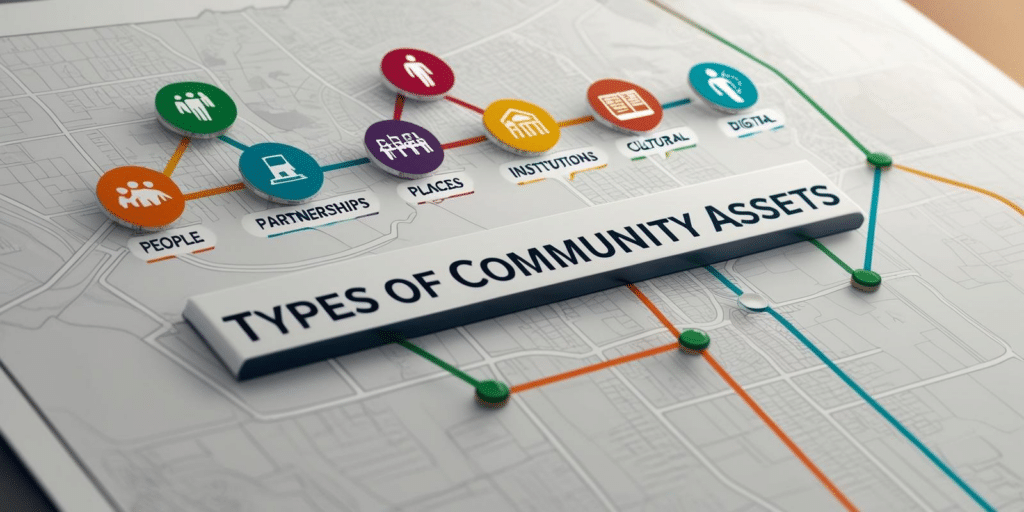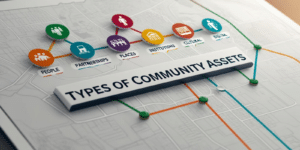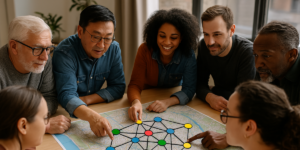Community asset mapping is a powerful practice embraced by nonprofits, public health agencies, local governments, and coalitions to illuminate and mobilize the inherent strengths within their communities. Instead of solely focusing on needs or deficits, this strengths-based approach builds upon what’s already working, fostering resilience and sustainable change.
But what exactly constitutes a “community asset”? It’s more than just a static list; it’s about understanding the dynamic web of resources that can improve the quality of community life. How do we move beyond a simple inventory to truly visualize and activate these assets in a relational and dynamic way?
In this article, we’ll not only break down the core types of community assets—people, places, and partnerships—but also delve into economic, institutional, cultural, and digital assets. We’ll explore how a comprehensive understanding of these assets, especially the connections between them, is crucial for effective community building. Furthermore, we’ll share how tools like the PARTNER CPRM platform help communities map not just what they have, but crucially, how those assets are connected and can be leveraged for greater impact.
Table of Contents
7 Types of Community Assets: Building Blocks for a Thriving Community
At its heart, a community asset is anything—a person, a place, a service, a business—that can be used to improve the quality of community life. Recognizing these assets is the first step towards empowering residents, fostering local control, and building more effective and lasting solutions to community challenges.
Here’s an overview of seven primary types of community assets, plus examples that illustrate their potential:
| Category | Examples |
|---|---|
| People | Local leaders, residents, youth, volunteers, staff with lived experience, everyday citizens with unique skills |
| Places | Parks, libraries, clinics, schools, faith centers, underutilized public spaces |
| Partnerships | Coalitions, cross-sector alliances, informal working groups, referral networks |
| Economic | Small businesses, employers, local funders, workforce training programs, credit unions |
| Institutional | Government agencies, universities, hospitals, nonprofits, school districts |
| Cultural | Arts organizations, museums, heritage events, traditional knowledge holders, cultural centers |
| Digital | Internet access, public Wi-Fi spots, digital literacy initiatives, open data portals |
Let’s explore each of these types in more detail, with examples and actionable insights for identifying, managing, and leveraging them in your community asset mapping project.

1. People: The Heartbeat of Community Capacity
People are the fundamental building blocks of every community. Individuals bring a wealth of lived experience, leadership, unique skills, and vital relationships that form the backbone of any successful change effort. Recognizing that every resident has potential contributions is key to unlocking a community’s full capacity.
🔸 Examples of People Assets:
- Community leaders: Trusted figures in neighborhoods, coalitions, or grassroots efforts
- Residents with lived experience: People who bring invaluable insight into specific challenges
- Youth leaders: Emerging changemakers who engage peers and influence priorities
- Volunteers: Community members offering their time, energy, and commitment
- Public-facing workers: Teachers, caseworkers, librarians, promotoras, etc.
- Everyday citizens with specific skills: Musicians, gardeners, mechanics, storytellers – talents that can enrich community life.
These individuals aren’t just resources—they are the connectors within local ecosystems. With PARTNER CPRM, you can track engagement, identify key influencers, and understand how individual relationships contribute to collective impact. Visualizing these connections can reveal hidden strengths and potential collaborators.
💡 Pro Tip!
Uncover Hidden Talents: The Community Talent Inventory
Go beyond formal roles. Make a list of 15–20 local individuals with influence, lived experience, or unique skills—even if they’re not part of a formal organization. Think broadly about hobbies, professions, and informal leadership.
Tag them by role (e.g., youth, elders, connectors, artist, builder), and note their current level of engagement. This gives you a relational entry point for deeper mapping and uncovers often-overlooked assets.

2. Places: The Physical and Environmental Foundation
Places encompass the formal and informal spaces where community life unfolds. These physical environments significantly influence access, connection, and equity. Recognizing even underutilized spaces as potential assets can unlock new opportunities.
🔸 Examples of Place-Based Assets:
- Libraries, schools, and universities: Centers for learning, gathering, and empowerment
- Faith-based institutions: Churches, mosques, temples—often hubs for social support and community events
- Parks and recreational spaces: Places for physical activity, nature, and community events
- Community centers and shelters: Vital resource access points for vulnerable populations
- Transit routes and infrastructure: Physical connectors between people and services
- Underutilized public spaces: Empty lots that could become community gardens, vacant buildings with potential for social enterprises.
Mapping these assets helps identify spatial gaps, accessibility issues, and opportunities for place-based interventions. Integrating GIS capabilities with relational data in PARTNER CPRM allows you to overlay geographic information with network data, leading to more strategic and equitable planning.
💡 Pro Tip!
Map for Access and Inclusivity
When identifying place-based assets, add simple yet crucial tags: “Publicly Accessible?” and “Culturally Welcoming?”
Not all places are equally accessible or inclusive. Use these tags to identify where your map might be missing safe, trusted, and welcoming spaces for priority populations, ensuring a more equitable distribution of community resources.

3. Partnerships: The Power of Relational Assets
While traditional asset maps often list tangible “things,” they frequently overlook relationships—arguably the most potent asset of all. Partnerships create synergy, enabling communities to align efforts, pool resources, and avoid duplication, leading to more efficient and impactful outcomes.
🔸 Examples of Partnership Assets:
- Cross-sector collaboratives: Public health + housing + education partnerships
- Nonprofit coalitions: Joint advocacy, data-sharing, or service alignment initiatives
- Public-private partnerships: Shared investment in infrastructure or workforce development
- Referral networks: Formal or informal linkages between service providers
- Academic-community partnerships: Research-practice collaborations
Traditional asset mapping often fails to capture the quality of collaboration—elements like trust, shared value, and alignment of goals. That’s where tools like PARTNER CPRM excel. By mapping partnerships, users can:
- Visualize who is connected to whom within the community ecosystem.
- Evaluate the strength and quality of ties between organizations and individuals.
- Identify isolated actors or critical gaps in the network.
- Spot over-reliance on single nodes (key players), highlighting potential vulnerabilities.
This relational data, visualized using social network analysis, is paramount for building community resilience, driving systems transformation, and achieving collective impact initiatives.
💡 Pro Tip!
Map Purposeful Collaborations, Not Just Contacts
Ask your partners: “Who are you actively collaborating with right now to achieve shared outcomes?”
Focus on current, purpose-driven connections—not just a list of contacts. This transforms your asset map into a real-time reflection of functional partnerships that are actively contributing to community goals.

4. Economic Assets: Engines of Opportunity and Sustainability
Economic assets are crucial for supporting livelihoods and fostering sustainable development within a community. These encompass institutions, actors, and programs that build local wealth and enhance workforce capacity.
🔸 Examples of Economic Assets:
- Local small businesses: From neighborhood stores to worker cooperatives
- Credit unions and community banks: Providing equitable financial services
- Chambers of commerce: Facilitating connections between business and community development
- Workforce development centers: Offering job training, re-skilling, and career pathways
- Local funders or grantmakers: Fueling community initiatives and innovation
Mapping these assets helps communities understand existing economic opportunities and identify areas where targeted investment can stimulate growth and create jobs.
💡 Pro Tip!
Tap into Local Business Networks
Reach out to your local Business Improvement District (BID) or small business support groups to identify local entrepreneurs, informal economies, and often-overlooked community contributors.
These organizations often have insights into which businesses are community anchors, who is actively hiring locally, or who might offer valuable in-kind support or sponsorship.

5. Institutional Assets: Anchors of Service and Governance
Institutions often provide stability, infrastructure, and the ability to convene diverse stakeholders. They can be significant providers of services and key partners in large-scale community initiatives. Understanding their roles and potential for collaboration is vital.
🔸 Examples of Institutional Assets:
- Local and state government agencies
- Hospitals and public health departments
- Universities and community colleges
- School districts
- Nonprofit anchor institutions
These entities frequently operate at scale and possess resources that can be leveraged for community-wide impact, making them crucial players in strategic partnerships.
💡 Pro Tip!
Beyond the Usual Suspects: Institutional Assets
When mapping institutional assets, go beyond the obvious large institutions. Consider smaller, specialized agencies or departments within larger entities that might have unique resources or expertise.
For example, within a university, look at specific research centers, community outreach programs, or even individual faculty members with relevant expertise. Within a city government, explore niche departments like the Office of Sustainability or the Department of Neighborhood Services. These smaller units can often be more agile and collaborative.

6. Cultural Assets: The Soul and Story of the Community
Cultural assets connect people to their history, identity, and traditions, enriching community life and fostering a sense of belonging. They are particularly important in building inclusive and equitable communities.
🔸 Examples of Cultural Assets:
- Arts organizations and galleries
- Community theaters and festivals
- Heritage or historical societies
- Indigenous knowledge holders
- Cultural centers for ethnic or immigrant groups
These assets often intersect with people and places and can serve as powerful catalysts for civic engagement, social cohesion, and celebrating the unique identity of a community.
💡 Pro Tip!
Deep Dive into Cultural Assets
Don’t just list cultural organizations. Map the networks between them and how they connect with the broader community.
Identify key cultural brokers, tradition bearers, or informal groups that may not have a formal organizational structure. Explore how cultural assets are used to build social capital, promote civic engagement, and preserve community identity. Consider mapping the flow of cultural knowledge and practices within the community.

7. Digital Assets: Technology as Essential Infrastructure
Increasingly, digital access is recognized as a fundamental community asset. In today’s interconnected world, identifying digital strengths and addressing gaps is crucial for equity and opportunity, especially in rural or underserved communities.
🔸 Examples of Digital Assets:
- Public Wi-Fi and broadband infrastructure
- Community tech hubs or digital literacy programs
- Open data portals and civic tech tools
- Shared digital platforms (e.g., for telehealth or resource navigation)
Mapping digital assets helps ensure that connectivity—and the myriad benefits it provides, from education and healthcare to economic opportunity—are equitably distributed across the community.
💡 Pro Tip!
Assessing Digital Equity, Not Just Access
When mapping digital assets, move beyond simply noting the presence of infrastructure. Assess digital equity, which encompasses access, skills, and usage.
Map not only who has access to technology, but also who knows how to use it effectively and who is actively benefiting from it. Identify digital literacy programs, community tech support initiatives, and efforts to bridge the digital divide. Consider mapping the availability of multilingual digital resources and culturally relevant content.
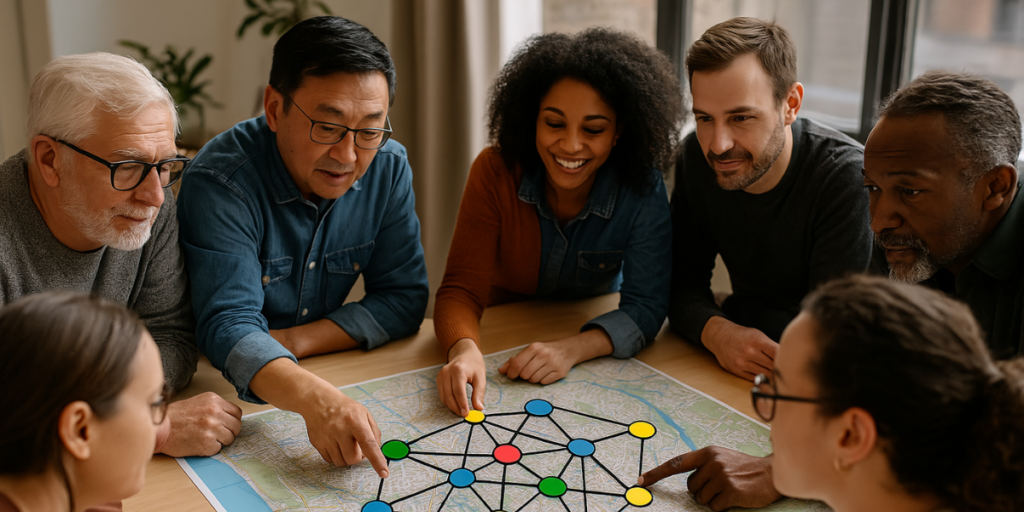
Moving Beyond Lists: The Power of Networked Assets
While identifying the different types of community assets is a crucial first step, the real transformative power emerges when we understand the connections between them. Who is working with whom? Where are there opportunities for greater collaboration? Who is currently on the periphery?
PARTNER CPRM helps organizations move beyond static lists to dynamic network intelligence by visualizing:
- The structure of partnerships and collaborations within the community.
- The levels of trust and value within these relationships.
- The alignment of goals and shared outcomes among network members.
- Areas of opportunity for new connections, potential risks of isolation, and strategic leverage points within the network.
This deeper level of insight is essential for coalitions, funders, public health agencies, and any community change initiative striving for greater efficiency, impact, and collective action. By understanding the interconnectedness of your assets, you can strategically foster collaborations and build a more resilient and thriving community.
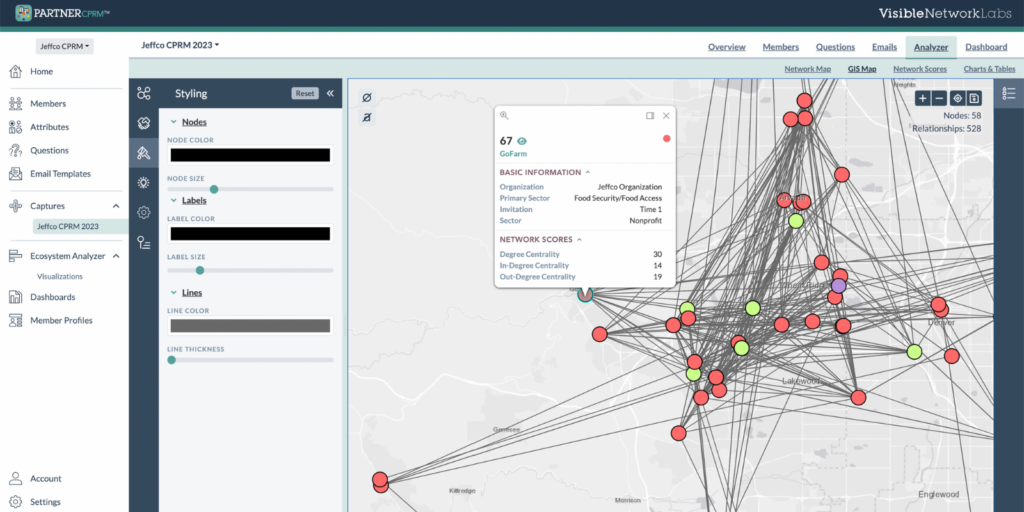
✅ Take the Next Step: Map Your Community's Potential
Whether you’re just beginning your community engagement work or seeking to deepen your understanding of your community’s strengths, mapping your assets—and the relationships between them—is a critical step forward. Ready to move beyond spreadsheets and static maps to unlock the power of your community’s network?
👉 Download our Free Ecosystem Mapping Template
👉 Try PARTNER CPRM Free to start visualizing your network
👉 Schedule a personalized demo with a network science expert
Visible Network Labs is dedicated to helping mission-driven organizations harness the power of relationships to build stronger, more connected communities. Let us help you uncover the full picture of your people, places, and partnerships—and the vital connections that bind them together.
Frequently Asked Questions (FAQs)
Q: What is the definition of a community asset?
A: A community asset is anything that can be used to improve the quality of community life. This can include people, physical structures or places, community services, businesses, and the skills and talents of individual residents.
Q: What are the benefits of community asset mapping?
A: Community asset mapping offers numerous benefits, including: providing a foundation for community improvement; empowering residents to take control; leading to more effective and longer-lasting change; providing a fuller understanding of a community’s strengths; and fostering a more positive and can-do attitude towards community development.
Q: What are the 7 types of community assets?
A: The seven main types of community assets includes people, places, partnerships, economic assets, institutional resources, cultural assets, and digital infrastructure. Recognizing the unique contributions of individuals and the potential of even underutilized spaces broadens this understanding and provides more powerful insights and transformative impact.
Q: Why are relationships considered community assets?
A: Relationships between organizations, sectors, and individuals are considered community assets because they create alignment, increase efficiency, and support shared goals. These connections enable communities to work together more effectively, pool resources, and achieve greater impact than they could alone. Tools like PARTNER CPRM help visualize and strengthen these vital connections.
Q: What are some examples of community assets?
A: Examples of community assets include:
People: Local leaders, residents with specific skills, volunteers.
Places: Libraries, parks, community centers.
Partnerships: Networks and collaborations.
Economic Assets: Local businesses.
Institutional Assets: Government agencies and schools.
Cultural Assets: Community festivals and cultural traditions.
Digital Assets: Public internet access and digital literacy programs.
Q: What’s the difference between asset mapping and needs assessments?
A: Needs assessments focus on identifying what’s missing or required, while asset mapping emphasizes the existing strengths and capacities within a community that can be leveraged for positive change. A strengths-based approach builds upon what’s already present.
Q: How can I identify community assets in my neighborhood?
A: Start by engaging community members in conversations, exploring your local area with a fresh perspective, utilizing surveys, and considering tools like the PARTNER CPRM platform to uncover both formal and informal assets, including individual skills and underutilized spaces. Collaborating with local leaders and community groups is also essential.
Q: How do you map community assets?
A: Community assets can be mapped in several ways. One method is to use a physical map to mark the location of groups and organizations. Another is to use software to create more complex and interactive maps. It’s also possible to create non-literal maps that illustrate the connections between different types of assets, showing how they interconnect and can be combined to meet community needs. Tools like Visible Network Labs’ PARTNER CPRM can be used to visualize the relationships between assets.
Additional Resources
Keep learning with these additional resources, blogs, and toolkits related to community asset mapping.
- Participatory Asset Mapping Toolkit – Community Science
- Asset Mapping Toolkit – Clear Impact
- Build a Community Asset Map – Learn ArcGIS
- Identifying, Mapping and Mobilizing Our Assets – UW Extension
- Seven Types of Community Assets – University of Memphis
